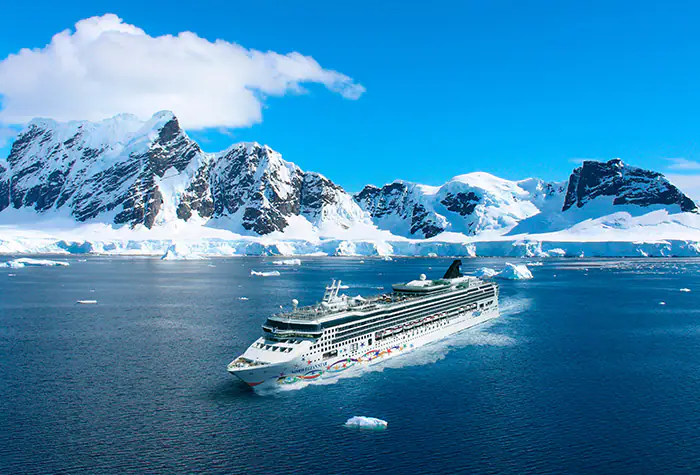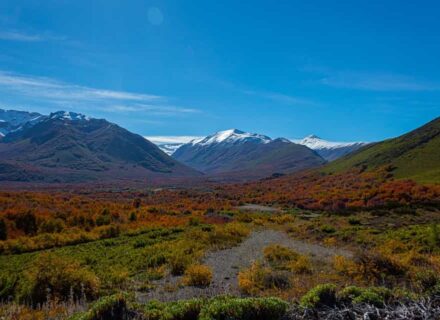Antarctica is often seen as a mystical realm, a place of breathtaking beauty and stark contrasts. The sheer magnificence of its landscapes, combined with its unique wildlife, makes it a prime destination for adventure cruises. These polar journeys offer travelers the chance to witness the grandeur of endless glaciers, navigate winding icy paths, and behold towering mountains, all while observing diverse wildlife in the air, sea, and on land.
The Allure of Antarctica
Scientific research suggests that Antarctica has existed since the time of Aristotle, yet human presence only emerged in the 1800s. Today, this vast continent, which is more than twice the size of Australia, is home to very few permanent residents. The majority of its land is dedicated to scientific research, free from mining, military, and nuclear activities, creating a safe haven for numerous animal species.
From your cruise, you can expect to encounter a range of wildlife, including whales, seals, seabirds, and, of course, penguins. The experience of observing these creatures in their natural habitat, set against the backdrop of stunning icy landscapes, is nothing short of magical.
Best Destinations for Antarctic Cruises
Ushuaia, Argentina – The Gateway to Antarctica
Ushuaia is the southernmost city in the world, characterized by its cold, windy climate. This vibrant city serves as a launching point for many Antarctic cruises. The surrounding areas are teeming with wildlife, including grey gulls and caracaras resting in the harbor, various species of seabirds soaring through the sky, and land animals like the Magellanic penguin.
Drake Passage – The Adventurous Route
The Drake Passage is known for its rough waters, but it is also the shortest route to Antarctica. While traversing these waters, you may spot albatrosses gliding above, shimmering icebergs, and massive whales. On calm days, dolphins, humpback whales, and fin whales can be seen frolicking in the waves. If your cruise crosses the Antarctic Convergence, where cold and warm currents meet, you might encounter entirely different bird species.
South Georgia – A Wildlife Wonderland
South Georgia is a true spectacle of nature, bustling with king penguins caring for their young and sea lions basking on the beaches. The abandoned whaling station of Grytviken is a historical site where you can find elephant seals, macaroni penguins, wandering albatrosses, and fur seals.
Falkland Islands – A Cultural and Natural Blend
The Falkland Islands offer a unique mix of South American culture and Victorian charm. Here, you’ll find a diverse array of bird species, including black-browed albatrosses, storm petrels, and petrels. The islands are also home to Magellanic, rockhopper, and yellow-eyed penguins. Don’t miss the local church, museum, and shipwrecks along the coast.
Antarctic Peninsula – Touching the Frozen Continent
On the Antarctic Peninsula, travelers can set foot on the frozen, mountainous land of Antarctica. Browning Bluff is known for its breeding colonies of gentoo and Adélie penguins, while leopard seals wait for their next meal in the water. Aboard a zodiac, you can explore the icebergs of Cierva Cove, spot humpback whales, crab-eater seals, and colonies of chinstrap penguins. Trinidad Island, known for its gentoo penguin nesting sites, is another popular destination on the western side of the peninsula.
South Shetland Islands – A Natural Paradise
Polar cruises often pass by Deception Island, where you can explore hot springs and an old whaling station surrounded by black-browed albatrosses, Antarctic petrels, and skuas. At Half Moon Island, you’ll find chinstrap penguins, while gentoo, Adélie, and macaroni penguins thrive in the area. The waters host leopard seals, Weddell seals, and whales, including fin and humpback whales.
Ross Sea – The Adventurer’s Playground
The Ross Sea is a hotspot for Antarctic expedition cruises, located near New Zealand. Its waters are home to orcas, humpback whales, and minke whales, as well as crab-eater, leopard, and Ross seals. Adventure activities might include helicopter trips to stunning landscapes, such as dry valleys that resemble Mars and the massive Ross Ice Shelf.
Elephant Island – A Historical Landmark
If your cruise visits Elephant Island, you’ll learn about the inhospitable cliffs that once housed 20 crew members of Sir Ernest Shackleton for four months after their ship was destroyed. Today, the island’s only residents are chinstrap penguins and seals.
South Orkney Islands – Research and Wildlife
The South Orkney Islands feature an Argentine research station founded in 1903 that collects meteorological data while surrounded by colonies of penguins and petrels. Fur seals have claimed some beaches, while whales swim in the nearby waters. Permits from the research station are required to walk on the beaches.
Antarctica Base Camp – A Scientist’s Outpost
Nestled among towering glaciers and pristine landscapes, Antarctica Base Camp is a vital outpost for scientists and adventurers exploring the stunning beauty of the icy continent. Visitors on small boat cruises to this remote region experience the rare opportunity to witness unparalleled wildlife, from penguin colonies to migratory whales, in an environment virtually untouched by human activity.
These cruises often include stops at research stations, such as the famous Port Lockroy, allowing travelers to glimpse the scientific efforts studying the impacts of climate change. Ideal for eco-conscious travelers, these intimate trips promote environmental responsibility and provide a deeper immersion into the wonders of Antarctica’s frozen desert.
Best Time for Antarctic Cruises
Antarctic cruises operate between November and March. In November, when temperatures are at their coldest, the icebergs are freshly carved, and the snow is pristine. Although wildlife is less abundant during this time, it is a great opportunity to witness courtship, mating, and nesting behaviors among penguins and seabirds.
From December to January, the days are longer, wildlife is more plentiful, and, of course, more tourists flock to the region. However, it’s a rewarding experience to see the hatching of penguin chicks and the birth of seal pups.
From February to March, some species have departed, and so have many visitors. Yet, whale populations peak during this time, and the weather is warmer, allowing for further exploration south.
How to Get to Antarctica
Travelers can access Antarctica from South America or New Zealand. The best international airports are Santiago (Chile), Buenos Aires (Argentina), Montevideo (Uruguay), and Christchurch or Wellington (New Zealand). These cities have daily international flights, as well as domestic flights to your departure point.
Departure Points for Antarctic Cruises
Most cruises depart from Ushuaia, Argentina, easily accessible by air from Buenos Aires or Santiago. Some itineraries offer flights directly to Antarctica from Punta Arenas (Chile) to avoid navigating the Drake Passage (consider flying from Santiago to Punta Arenas for this option). Other cruises depart from the port of Montevideo, Uruguay, which is also easy to reach by plane. To reach Bluff, New Zealand, travelers must fly from Wellington or Christchurch to Invercargill and take a bus to Bluff.
Tips for Antarctic Cruises
Plan Ahead
It is best to book early to secure your spot, especially if you plan to travel between December and January. To avoid issues with flight delays, consider arriving one or two days before your cruise’s departure. Some cruises may end in a different port than where they started, so plan your flights accordingly.
Choose the Right Voyage
When selecting your cruise, consider factors such as susceptibility to seasickness, interest in land exploration, desire to visit historical sites, tolerance for waiting and crowds, wildlife preferences, and comfort with cold temperatures.
What to Pack
Staying comfortable in a variety of temperatures is essential. Layering is key, allowing you to adjust your clothing based on temperature or activity levels. Include rain gear, sunscreen, and thermal insulation for your hands, head, and feet. Some cruises provide parkas. Additionally, don’t forget your cameras and binoculars!
Seasickness
The Drake Passage is infamous for its rough waters, but some people experience seasickness even in calm conditions. If you’re prone to motion sickness, consult your doctor and bring necessary medication.
Travel Advisory
Before visiting Antarctica, Americans, Canadians, and Australians must pay the Argentine Reciprocity Fee online. There is no Antarctic currency, but in the Peninsula, Port Lockroy accepts dollars, pounds, and euros. Most cruises charge expenses to your credit card.



